QBARS - v20n4 The Rhododendron Park in Bremen
The Rhododendron Park in Bremen
Johann Berg, Bremen, Germany

|
| Fig.58. R. 'Humboldt' in the Rhododendron Park. |
During the past three decades the present Rhododendron Park arose on an area, formerly owned by a famous family of tradesmen and laid out as a kind of natural park. This area, situated in the eastern neighborhood of Bremen, and of a most country like appearance, became the property of the State of Bremen about 1911.
In 1936 the State of Bremen, represented by its garden office (Gardenbauamt) began to establish here the new Botanical Garden, extending all in all over 35 hectares, and, as a part of this, the Rhododendron Park of nowadays, reaching a dimension of nearly 16 hectares, and containing especially Rhododendrons and Azaleas, natural species as well as hybrids. Also a considerable number of evergreen trees and shrubs, including Heathers, Hollies, Prunuses, Box-Trees and some evergreen ground-covering plants, are displayed as examples of how they should be used in gardening or landscaping work, all together about 1000 species and varieties.
As a suitable place to establish a central examination garden this area showed itself favorable in more than one regard. The soil proved to be sufficiently acid and there was an adequate measure of subsoil water and of moisture in the air. Furthermore, the area was equipped with a large stock of old and wonderful trees, oaks mostly and some beeches, providing half or full shade, as much as required for the Rhododendrons and the other evergreen trees and shrubs. And, finally, it was situated in the near neighborhood of the most important and well - known nurseries engaged especially in Rhododendrons and evergreens, thereby making easy good connections between these and the work done here in the Rhododendron Park.
The presence of these nurseries as well as of the Rhododendron Park in this northwestern corner of Germany, around the town of Oldenburg, (easily accessible from Bremen in the western direction) obviously is not a casual event, but a distinctly reasonable development when one considers the conditioning factors of our climate.
From the meteorological observations during 40 years, including moisture, rainfall, sunshine and temperature, have been calculated approximate monthly averages as follows:
-
Moisture: diminishing from a max. of 90% humidity in January to a min. of ca. 74% in May, and raising again constantly to the max. of 90 in Jan.
- Rainfall: rises from a min. of ca. 40 mm in February to a max. of nearly 80 mm in June, decreases then to 43 mm in November, increases then to ca. 55 mm in January and reaches a min. in February as above.
- Sunshine: reaches a max. of ca. 250 hours in May, diminishes then to to nearly 190 hours in August and further to the min. of ca. 30 hours in January and February, and comes up then comparatively fast to the max. as mentioned above.
- Temperature: obviously the max. may be found in July, descending then gradually to the min. of +2° C. in January, and ascending just as gradually to the max. of +18° C. in July. This curve is a nearly symmetric one.
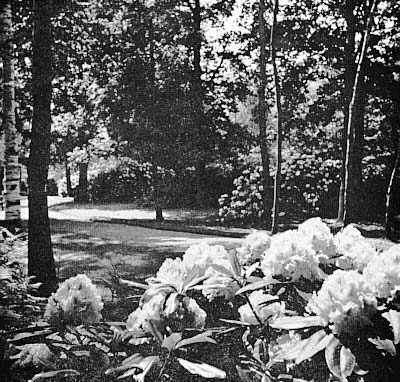
|
|
Fig. 59. R. 'Von Oheimb Woislowitz' in front,
Seidel hybrids in the background. |
We should bear in mind, that not nearly all species or hybrids, belonging to the large genus 'Rhododendron' will be found suitable or doing well under the conditions in any one garden, and from this point of view it may be understood easily, how essential an examination garden like this must be now and in the future.
It is a hard fact, that a great number of natural species have been imported from regions quite different from ours with respect to climate. Moreover, we should remember that most of the precious colors like red or yellow, as well as the largeness of the flowers, originate in tender species.
As a consequence of this, every improvement by means of breeding is accompanied by insecurity and danger of unreliability, and here, no doubt, the danger will be greater than anywhere in the immediate Gulf Stream region. Therefore the direction and the purpose of our work should be noted; to plant everything called Rhododendron or Azalea that might possibly be suitable under the conditions in this area. Then: to examine, to compare and to report any feature and peculiarity, for example: growth, hardiness against sun, dryness and frost, time of blossoming, color, power of resistance against any kind of check. And finally, these data, brought together during a number of years, are important as a basis to recognize the really valuable species or hybrids, and particularly to recommend these to our numerous visitors as well as to the nurseries. At this point it may be stated that nearly every plant in the Rhododendron Park is labeled during the time of blossom.
However, the Rhododendron Park ought not to be only a check field. On the contrary, the citizens of Bremen as well as the numerous visitors, coming from afar, enjoy this gorgeous performance of glowing flowers, of sparkling colors, and the landscape gardening, carried out to attain the best possible appreciation. The garden is laid out expansively, full of sunrays and shadow, with sheets of glittering water and a couple of ducks thereupon, with wide green carpets of lawn, with a playground for the children and for all even a sundial.
Beside this provision for general human enjoyment, however, the specialist in Rhododendrons or in evergreens as a whole, is enabled to find here interesting facts about gardening matters to a degree he might expect. Those facts may be found especially in the so-called "nursery," being truly an "assortment plantation," far from any landscaping style, but assembling all the species, varieties and hybrids from near and far, in order to facilitate the work of classification and comparison, of examination, identification and evaluation.
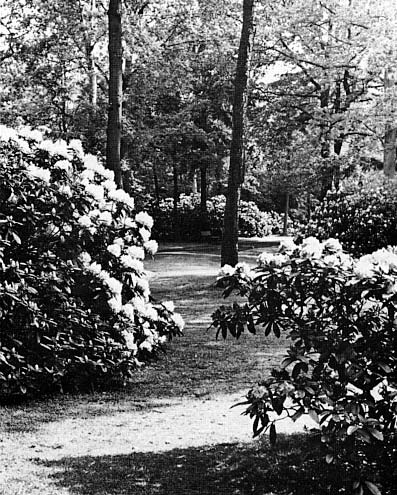
|
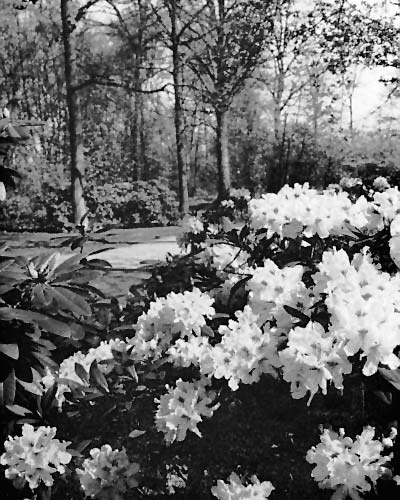
|
|
Fig. 60. R. 'Album Novum' (left),
R. 'Hymen' (right) |
Fig. 61. Rhododendron caucasicum |
At this point may be mentioned, as an aim of the examination work done here, the maintenance of a profile assortment of the genera named above, including the best approved varieties as well as the newest stocks, originating from breeding or importation, for the purpose of tests and trials. An object of this is to eliminate varieties as soon as they become overhauled by improved ones and therefore become unnecessary. Another aim is worthy enough to be emphasized here: to set up and show some examples, in an instructive manner, of how to handle these evergreens, and how to settle them in our own garden. Special attention might be called to the comparatively numerous but widely unknown group of the evergreen ground-covering plants already mentioned above.
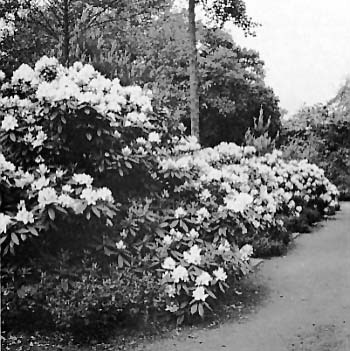
|
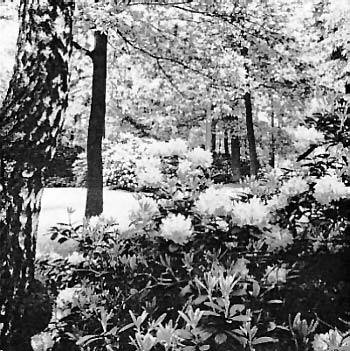
|
|
Fig. 62. R. 'Madam Masson' in foreground then
'Leopardi', 'Hero' and 'Genoveva'. |
Fig. 63. R. 'Etzel' in the Bremen
Rhododendron Park |
This combination of the serious in gardening with the lighter, purely enjoyable side is attributable to the State of Bremen, which is maintaining this representative central park for Rhododendrons and other evergreen plants, and which is carrying the whole expensive burden for no other reason than to provide enjoyment and information to all those who want to make use of the garden.
A name-list of hybrids and varieties which have proved to be sufficiently hardy and vigorous here, perhaps may be welcome and is given below as follows:
|
1). Large-flowering, perfectly hardy Rhododendron hybrids. |
|
|
'Album Novum' |
'Everestianum |
|
'America' |
'Gomer Waterer' |
|
'Catawbiense Album' |
'Lee's Dark Purple' |
|
'Catawbiense Boursault' |
'Madame Carvalho |
|
'Catharine van Thol' |
'Parsons Gloriosum' |
|
'Charles Dickens' |
'Purpureum Elegans' |
|
'Cunningham's White' |
'Roseum Elegans' |
|
'Dr. H. C. Dresselhuys' |
'Van der Hoop' |
|
'Dr. V. H. Rutgers' |
'Van Weerden Poelman' |
|
'Edward S. Rand' |
|
|
2). Large-flowering hybrids, showing more desirable colors,
|
|
|
'Britannia' |
'Leopardii' |
|
'Burgemeester Aarts' |
'Louis Pasteur' |
|
'Direktor E. Hjelm' |
'Madame Masson' |
|
'F. D. Godman' |
'Mrs. P. den Ouden' |
|
'Goldsworth Yellow' |
'Mrs. R. S. Holford' |
|
'Homer' |
'Pink Pearl' |
|
'Holbein' |
'Prof. Hugo de Vries' |
|
'Inamorata' |
'Purple Splendour' |
|
'Jacksonii' |
'Sappho' |
|
'James Marshall Brooks' |
'Susan' |
|
'Kate Waterer' |
Van den Broeke' |
|
'Lady Annette de Trafford' |
'William Austin' |
|
3). Seidel's hybrids (bearing their raiser's name), large-flowering,
|
|
|
'Alfred' |
'Humboldt' |
|
'Allah' |
'Hymen' |
|
'Bibber' |
'Leopold' |
|
'Bismarck' |
'Mexico' |
|
'Dietrich' |
'Oldewig' |
|
'Genoveva' |
'Omega' |
|
'Gudrun' |
'Raphael' |
|
'Hero' |
'Scharnhorst' |
|
'Holger' |
'Von Oheimb Woislowitz' |
|
4). Hybrids suitable for forcing. |
|
|
'Boule de Neige |
'Humboldt' |
|
'Britannia' |
'James Marshall Brooks' |
|
'Cynthia' |
'Kate Waterer' |
|
'Doncaster' |
'Madame de Bruin |
|
'Fruhauf' |
'Pink Pearl' |
|
'Homer' |
'Prof. Hugo de Vries |
|
5). Rhododendron hybrids, low growing, some of them being
|
|
|
Crosses of R. repens |
|
|
'Baden-Baden |
'Frühlingszauber' |
|
'Elisabeth Hobbie' |
'Scarlet Wonder' |
|
'Gertrud Schäle' |
|
|
Crosses of R. williamsianum (raiser: D. Hobbie) |
|
|
'Bremen' |
'Wega' |
|
Oldenburg' |
|
|
Crosses of R. haematodes (raiser: G. Arends): |
|
|
'Bremen' |
'Gnom' |
|
'China Boy' |
|
|
Crosses of different origin: |
|
|
'Blue Tit' |
|
|
'Praecox' |
|
|
6). Azalea hybrids |
|
|
a). The so-called 'Ghent Hybrids': |
|
|
'Bouquet de Flore' |
'Pallas' |
|
'Goldlack' |
'Sang de Gentbrugge' |
|
'Narcissiflora' |
'Daviesii' |
|
'Roi des Belges' |
'Nancy Waterer' |
|
'Corneille' |
'Pucella' |
|
'Joseph Baumann' |
'Unique' |
|
b). The Mollis Hybrids: |
|
|
'C. B. van Nes' |
'Chevalier de Reali' |
|
'Consul Pêcher' |
'Directeur Moerlands' |
|
'Dr. M. Oosthoek' |
'Hugo Hardijzer' |
|
'Kosters Brillian Red' |
'Nicolaas Beets' |
|
c). The Rustica Hybrids |
|
|
'Freya' |
'Phidias' |
|
'Phebe' |
'Norma' |
|
'Il Tasso' |
'Velasquez' |
|
d). The Occidentale Hybrids: |
|
|
'Exquisita' |
'Magnifica' |
|
'Irene Koster' |
|
|
e). The so-called 'Japanese Azaleas': |
|
|
'Agger' |
'Joseph Hayden' |
|
'Beethoven' |
'Kathleen' |
|
'Betty' |
'Lister' |
|
'Bever' |
'Multiflora' |
|
'Diemel' |
'Muttertag' |
|
'Eder' |
'Neye' |
|
'Favorite' |
'Noordtiana' |
|
'Fedora' |
'Obtusum var. amoenum' |
|
'Gretchen' |
'Palestrina' |
|
'Hatsugiri' |
'P. W. Hardijzer' |
|
'Hinodegiri' |
'Oester' |
|
'Hinomayo' |
'Sorpe' |
|
'John Cairns' |
'Wipper' |
|
f). Natural species of Rhododendron, proven to be recommendable ones. |
|
|
R. albrechtii |
R. minus |
|
R. ambiguum |
R. russatum |
|
R. augustinii |
R. schlippenbachii |
|
R. catawbiense |
R. smirnowii |
|
R. micranthum |
R. vaseyi |
|
7). Evergreen ground-covering plants. |
|
|
1). Herbaceous: |
|
|
Asperula odorata |
Tiarella cordifolia |
|
Epimedium, several species |
Vinca minor |
|
Glechoma hederacea |
Waldsteinia geoides |
|
Lamium galeobdolon |
Waldsteinia ternata |
|
Pachysandra terminalis |
|
|
2). Ligneus: |
|
|
Arctostaphylos uva-ursi |
Gaultheria shallon |
|
Cotoneaster dammeri |
Hedera helix , several varieties |
|
Euonymus fortunei 'Vegetus' |
Vaccinium macrocarpum |
|
Gaultheria miqueliana |
Vaccinium vitis-idaea |
|
Gaultheria procumbens |
|
The results of the tests and examination work are published, together with other articles about evergreens, in the German Rhododendron Society's Yearbooks.
